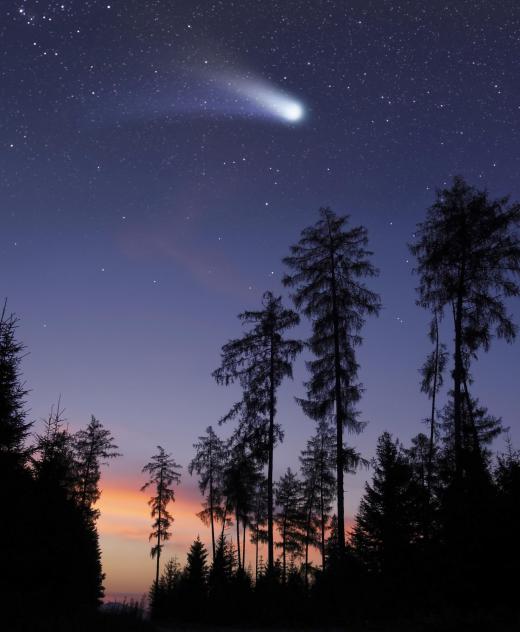What is Solar Wind?
 Michael Anissimov
Michael Anissimov
The solar wind is a stream of charged particles flowing out from the Sun, or any star, in all directions. It is mostly made up of free protons and electrons (plasma) with energies of about 1 keV (kilo-electron-volt). This quite energetic, but solar wind is usually harmless because of its low density. It extends outwards about 100 AU (astronomical units, Earth-Sun distances), about three times as far from the Sun as the orbit of Neptune, at which point it collides with the interstellar medium. The region where this wind is dominant is known as the heliosphere.
It is not completely known how the solar wind escapes the Sun and travels outward. It is partially due to the extremely high temperature of the corona, thehighest layer of the Sun's atmosphere, which ranges between 1 and 3 million Kelvin (1 and 3 million Celsius, 1.8 and 5.4 million Fahrenheit), reaching occasional highs of 10 million Kelvin. The high temperature of the corona is an unsolved question in physics itself, but the speed of the wind as it is ejected from the Sun -- between 400 and 700 km/s -- is another mystery. Even taking into account the high temperature of the corona, these particles must be getting some additional kinetic energy from somewhere to escape the Sun at the speed they do. The magnetic fields generated by free electrons may contribute to the acceleration of protons away from the Sun.

The solar wind is the source of various phenomena visible from Earth, including the aurorae (Northern Lights and Southern Lights), geomagnetic storms, the most severe of which can damage power grids and put astronauts in danger, and the plasma tails of comets. The Sun emits about 6.7 billion tons of solar wind per hour, which sounds like a lot, but becomes practically nothing when spread out across the vast expanse of space. An Earth-mass of wind is ejected only every 150 million years, and the Sun has only lost 0.01% of its mass over its 4.57 billion year age. Other stars, especially Wolf-Rayet stars, lose much more of their mass to solar wind over time. While the Sun would require 50 trillion years to eject all its mass via the wind, a Wolf-Rayet star requires only about 100,000.

The solar wind is the primary phenomenon in space for a large distance, but not forever. The influence of this wind begins to falter at the termination shock, about 75 AU from the Sun, where its velocity decreases from supersonic to subsonic. The space probe Voyager 1 reached the termination shock on 23-24 May 2005. Data sent back from its sensors has given scientists a better idea of how dynamics change when the solar wind is not the primary influence on the local space environment.
AS FEATURED ON:
AS FEATURED ON:












Discussion Comments
@GenevaMech- There have been a few notable solar flares that have created solar winds that disrupted everyday life. The most notable in (relatively) recent history is the solar super storm that occurred in 1859. The storm was so strong that it caused telegraph disruptions that shocked employees and started fires. The storm created a coronal mass ejection that only took 18 hours to travel to the earth. It created auroras that were visible as far away from the poles as Hawaii, Cuba, and Italy.
Two more recent events in March and August of 1989 caused an economically damaging blackout in Montreal/Quebec and fried microchips in computers that caused the Toronto Stock Exchange to shut down. Luckily, there are safeguards against these events. They can be predicted, and it usually takes three or four days for the storm to reach the Earth. Most grids also have relays that will trip when hit by a large EMP preventing overload and damage.
This was an interesting article. At first, I thought this article was going to cover power plants that combine solar and wind power.
How often does solar wind create electromagnetic storms that affect the earth? Has there ever been a power outage attributed to these types of storms? What are the risks of a large solar flare causing a dooms day scenario?
Post your comments